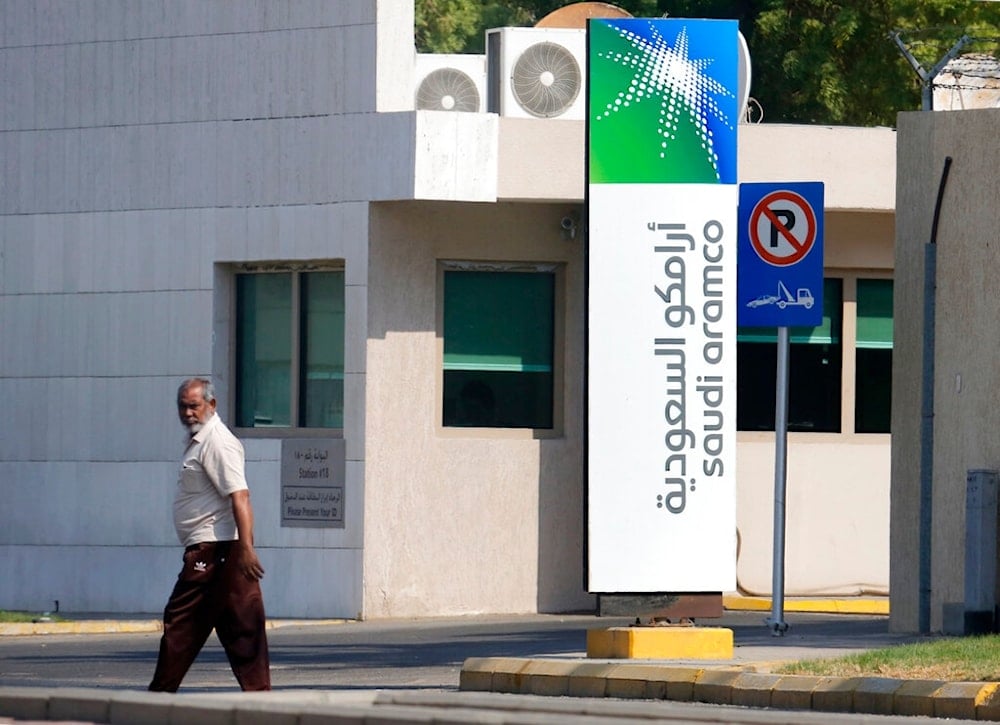Aramco no longer commands premium after stock decline
Saudi Aramco shares drop 14% in 2024, underperforming peers as investors weigh dividend cuts, oil surplus, and weaker long-term growth.
-

In this Nov. 3, 2019, file photo, a man walks past a compound for Saudi Aramco in Jiddah, Saudi Arabia. (AP)
For years, Saudi Aramco has held its position as the world's largest oil company, yet this year, its shares have underperformed compared to those of its industry peers, marking the weakest performance in the group, Bloomberg reported on Monday.
As Western oil giants experienced a recovery in their share prices, Aramco’s stock has declined by 14%, underperforming not only its global peers but also the broader Saudi market index, where it has posted steeper losses, sinking to levels last seen during the pandemic.
Investors are grappling with multiple concerns, including a potential dividend reduction, an approaching global oil surplus, and weaker long-term growth prospects compared to rivals, all of which indicate that Aramco’s position as the premier state-owned oil company may be weakening, with the company opting not to provide a comment on the matter.
“National oil companies typically trade at discounts to Western integrated oils, Aramco was the exception,” Allen Good, a strategist at Morningstar Investment Services, told Bloomberg, adding that “the market may be resetting valuations lower to align with those of national oil company peers.”
Billion-dollar slump
Aramco has experienced a dramatic decline, shedding over $800 billion in market value since its 2022 peak of nearly $2.4 trillion, with the Saudi government and its sovereign wealth fund retaining a 98% stake, meaning the downturn could limit their ability to generate funds through future share sales, a critical revenue stream for financing the kingdom's economic diversification efforts.
The current share price of Aramco sits roughly 12% below the 27.25 riyals per share level set in its 2024 secondary offering, while trading nearly 19% lower than its average price since its 2019 market debut.
Despite its recent struggles, Aramco remains the world's most valuable oil company with a $1.55 trillion market capitalization, maintaining its position as the industry's top dividend payer while boasting a strong balance sheet that provides flexibility to borrow for growth initiatives when needed, with Bloomberg data showing zero sell ratings among covering analysts.
Analysts project Aramco's adjusted second-quarter net income will drop to approximately $24 billion when results are released on August 5, marking roughly a 20% decrease from the same period last year, according to Bloomberg-compiled estimates.
Prospects of sustained losses concern investors
Investors are weighing not only oil prices and profits, but also responding to the sharp reduction in performance-linked dividends for 2024, as Aramco anticipates modest growth in its base dividend, with total payouts expected to decline to approximately $85 billion this year, compared to $124 billion in 2023.
Investors are scrutinizing Aramco's growth prospects as competitors like BP and Shell scale back renewable energy ambitions to prioritize oil and gas, while Exxon Mobil and other non-OPEC+ producers expand output in the Americas, positioning them to drive most global supply growth through 2027.
While OPEC+ gradually raises production, Saudi Arabia is preparing to boost its output to nearly 10 million barrels per day by September, representing an increase of 1 million barrels from April levels, though Aramco's production will remain significantly below its maximum capacity of 12 million barrels per day.
Unrealized potential
Aramco estimates that utilizing its currently idle production capacity could generate tens of billions in additional cash flow, amid plans to replace domestic crude consumption for power generation with natural gas and renewable energy sources, potentially freeing up 1 million barrels per day of export capacity by 2030.
Saudi Arabia's fiscal position, facing a deficit as oil trades significantly below the IMF's estimated $92 per barrel breakeven price, presents additional uncertainty for Aramco investors, raising the possibility of further government share sales in the company.
Saudi Arabia generated over $12 billion from its secondary Aramco share offering slightly more than a year ago, though the stock declined approximately 2% in the week after the offering's completion and dipped below the 27.25 riyal offering price by early August 2024, remaining consistently beneath that threshold since March of this year.
Market analysts highlight Aramco's limited public float as a key factor influencing its stock performance, with just 2% of shares available for public trading while the Saudi government and sovereign wealth fund control the remaining 98%.
Varun Laijawalla, an emerging markets portfolio manager at Ninety One in London, told Bloomberg that the persistent threat of additional government stake sales may weigh on the share price as significantly as fluctuations in crude markets or dividend adjustments. The potential for future dilution creates an ongoing overhang that investors must consider alongside traditional valuation metrics.

 5 Min Read
5 Min Read










